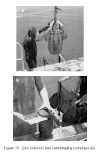
Sediment Sampling Surveys (con't) Box and Push-Piston coring- Objective and Accomplishments:
In June 1998 over 70 box cores were acquired from Lake Pontchartrain. Thirty of the box cores reoccupied sites from the previous year and were subsampled in a similar fashion. Sixteen of the box cores were taken from sites previously sampled with the underway surficial sediment sampling method described below. At these sites three box cores were acquired per site and each core was subsampled using the 4 inch core liners in 2cm intervals down to 10cm. The remaining 24 box cores were subsampled in a similar fashion, except sampling proceeded down to 16cm. These cores where acquired from areas interpreted to have high concentrations of trace metals in the sediments, based on previous sediment surveys. Dredge pits along the southern shore of the lake were also targeted. The samples were frozen to retain organic carbon. In addition to sampling with the foot long core liners, up to one meter long subsamples were taken from 16 of the box cores using 4 inch diameter, meter long pvc pipe that was pushed into the sediment, capped and retrieved. These subcores were split into two halves along core, one half was stored whole, the other half was subsampled as described in the methods section below. The task objective of the box and piston-core surveys was to establish a surface and downcore trace metal contaminant throughout the lake. The sediments were analyzed for 30 different elements related to anthropogenically-derived contamination. Additionally, radioactive isotope-decay rates (Berrilium-7) were measured downcore to determine sediment accumulation patterns within the basin. Results of these analyses can be used to define hot spots of contaminant accumulation within the lake. Accomplishments to date include a plot of recent sediment accumulation rates throughout Lake Pontchartrain that can be compared with other models of physical parameters that affect sediment distribution, such as water current patterns or floodwater discharge into the lake. Also, downcore metal profiles provide a baseline distribution of contaminants throughout the lake as well as an indication of whether the sediments have been reworked since initial deposition. Further studies of the sediment samples include efforts to evaluate the validity of the underway surficial sediment sampling system through correlation with surficial material retrieved from the box cores. Also, downcore pollen assemblages will be studied to provide a history of regional changes in vegetation (Figure 14). Finally, the meter long sub cores retrieved from the box cores will be x-rayed to detect evidence of laminations and bioturbation within the sediments. This information will provide insight into accumulation and mixing patterns in the near surface.
Additional sampling included four inch diameter, one meter long sections of PVC sewer pipe, cut into two halves length-wise. The two halves were recombined with duct tape and inserted into the box core. The bottom of the pipe is capped and the subcore is retrieved by hand. On deck the tape is cut away, end caps are provided and the subcore is split lengthwise using a hack-saw blade to produce two subcore halves. One half is sealed in plastic wrap and archived. The other half is sectioned into one-inch intervals downcore. Each interval is removed and placed into a labled ziploc sample bag. These samples were later frozen. The piston core is a PVC barrel with an inner barrel that can be pushed into the sediment using attached handles. The corer can be operated over the side of the boat and is capable of retrieving 1 meter long cores. Once the inner barrels are onboard and removed, they are capped, inspected for quality, and measured. During retrieval and transport, the cores are kept vertical at all times to minimize surface disturbance. At the lab, a PVC piston was inserted in the bottom of the core liner and the core is placed on a stand designed to hold it stationary while a hydraulic jack is used to raise the piston and extrude the sediment out the top of the core barrel. A ring of the same diameter of the core barrel, cut to the appropriate height, is used for measuring the thickness of each interval. When the sediment reached the top of the ring, a thin aluminum plate was inserted between the ring and core liner. The plate was carefully removed to avoid disturbing the underlying sediment.
|
|||||||||||||||||||



